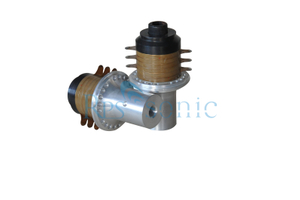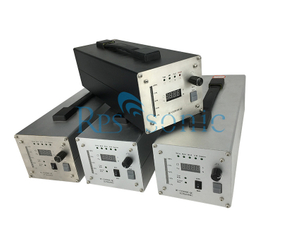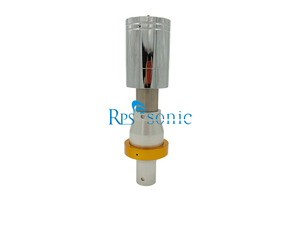What's the Principle and theory of ultrasonic plastic welding machine?
With the rapid development of the material industry, the application of composite materials such as plastics and metals with light weight, low friction, corrosion resistance and easy processing has received much attention. Various products of plastics have penetrated into various fields of daily life of people, and are also widely used in aviation, shipbuilding, automobiles, electrical appliances, packaging, toys, electronics, textiles and other industries. However, due to factors such as the injection molding process, a considerable number of plastic products with complicated shapes cannot be injection molded at one time, which requires bonding, and the plastic bonding and heat sealing processes that have been used for many years are quite backward, not only inefficient, but also bonding. The agent also has certain toxicity, causing problems such as environmental pollution and labor protection. The traditional process of this kind can not be applied to the development needs of the modern plastics industry, so a novel plastic processing technology - ultrasonic plastic welding stands out with its superiority of high efficiency, high quality, beautiful appearance and energy saving. Ultrasonic plastic welding machine does not add any adhesive, filler or solvent when welding plastic products, nor does it consume a lot of heat source. It has the advantages of simple operation, fast welding speed, high welding strength and high production efficiency. Therefore, ultrasonic welding technology is becoming more and more widely used.
The principle of ultrasonic plastic welding machine?
When ultrasonic waves act on the thermoplastic plastic contact surface, high-frequency vibrations of tens of thousands of times per second are generated. This high-frequency vibration reaches a certain amplitude, and the ultrasonic energy is transmitted to the weld zone through the upper weldment, because the weld zone is two The joints at the welded joints have a large acoustic resistance, so local high temperatures are generated. Moreover, due to the poor thermal conductivity of the plastic, it can not be dissipated in time and gather in the weld zone, so that the contact faces of the two plastics melt rapidly, and after a certain pressure, they are integrated into one. When the ultrasonic wave stops, let the pressure last for a few seconds to solidify it, thus forming a strong molecular chain for welding purposes, the welding strength can be close to the strength of the raw material. The quality of ultrasonic plastic welding depends on the amplitude of the transducer welding head, the applied pressure and the welding time. The welding time and the welding head pressure can be adjusted. The amplitude is determined by the transducer and the horn. These three quantities have a suitable value for each other. When the energy exceeds the appropriate value, the melting amount of the plastic is large, and the welding material is easily deformed; if the energy is small, the welding is difficult, and the applied pressure cannot be increased. This optimum pressure is the product of the length of the side of the welded portion and the optimum pressure per 1 mm of the edge. Ultrasonic welding is a high-tech technology for welding thermoplastic technology. Various thermoplastic rubber parts can be processed by ultrasonic welding without adding solvent, adhesive or other auxiliary products. The advantage is to increase productivity and reduce cost. improve product quality.
Ultrasonic plastic welding principle: The generator generates 20KHZ, (or 15KHZ) high-voltage, high-frequency signal, through the conversion system, converts the signal into high-frequency mechanical vibration, which is applied to the workpiece of plastic products, through the working surface and the intrinsic intermolecular The friction causes the temperature to be transmitted to the interface to rise. When the temperature reaches the melting point of the workpiece itself, the workpiece welding port is rapidly melted, and then filled in the gap between the interfaces. When the vibration stops, the workpiece is simultaneously cooled and fixed under a certain pressure. , to achieve the perfect welding.
II.How does ultrasonic welding work?
The principle of ultrasonic welding is to convert a 50/60 Hz current into 15, 20, 30 or 40 kHz by means of an ultrasonic generator. The converted high frequency electrical energy is again converted by the transducer into a mechanical motion of the same frequency, and then the mechanical motion is transmitted to the welding head through a set of amplitude modulator devices that can change the amplitude. The horn transfers the received vibrational energy to the joint of the workpiece to be welded, in which the vibrational energy is converted into thermal energy by friction to melt the plastic. Ultrasound can be used not only to weld hard thermoplastics, but also to fabrics and films.
The main components of a set of ultrasonic welding systems include ultrasonic generators, transducer/amplifier/welding head triples, molds and frames.
III. what's the composition and function of ultrasonic plastic welding machine
Ultrasonic plastic welding machine consists of pneumatic transmission system, control system, ultrasonic generator, transducer and horn and mechanical device.
1. Pneumatic transmission system
Including: over-clamps, pressure reducing valves, oil misters, commutators, throttle valves, cylinders, etc.
In operation, the air cylinder is first driven by the air compressor to drive the ultrasonic transducer vibration system to move up and down. The air pressure in the medium and small power ultrasonic welding is adjusted according to the welding needs.
2, control system
The control system consists of a time relay or an integrated circuit time timer. The main functions are as follows: First, control the operation of the pneumatic transmission system, so that the pneumatic valve is opened under the timing control during the welding, the pressure of the cylinder is lowered to lower the welding head, and the workpiece is pressed under a certain pressure, and the pressure is maintained for a period of time after the welding. Then, the control system reversing the gas path valve to make the welding head rise and return; secondly, controlling the working time of the ultrasonic generator, the system automates the entire welding process, and only starts a button to generate a trigger pulse during operation, and can automatically complete In the entire process of this welding. The order of the whole control system is: power start-trigger control signal pneumatic transmission system, cylinder pressure welding head descends and presses the welding trigger ultrasonic generator work, emits ultrasonic waves and maintains a certain welding time to remove ultrasonic emission to maintain a certain pressure time to depressurize The welding head is lifted and the welding is over.
3, ultrasonic generator
1) Ultra-high-power plastic welding machine with high power, the generator signal adopts phase-locked frequency automatic tracking circuit, so that the output frequency of the generator is basically consistent with the resonant frequency of the transducer.
2) The generator used in the ultrasonic plastic welding machine with power above 500W uses a self-excited power oscillator and also has a certain frequency tracking capability.
IV.What's the core parts in ultrasonic plastic welding machine
1) Transducer
The acoustic system for ultrasonic plastic welding machines consists of three parts: 1 drive part 2 fixed part 3 working part. In the above three components, the drive is the core, generally using a longitudinally vibrating transducer clamped by a bolt, wherein the half-wavelength longitudinal vibrator and the quarter-wavelength longitudinal vibrator, the half-wavelength longitudinal vibrating and the half-wavelength concentrator The connections form a full-wavelength plastic welding transducer, and the quarter-wavelength longitudinal vibrator is connected to a quarter-wave concentrator to form a half-wavelength transducer.
2) Horn
Different horn are required for different welding objects. Whether it is near-field welding or transmission welding, only a half-wavelength horn can achieve the maximum amplitude of the welding end face.
The horn has two kinds of amplitude and no amplitude amplification. The horn of the acoustic system for plastic welding machine is usually made of aluminum alloy. The end face is plated with hard alloy. When the power is high, it is also made of titanium alloy material. In this case, the fatigue strength of the material is more than twice as high as that of the aluminum alloy.
V. ultrasonic plastic welding machine models and specifications?
Ultrasonic plastic welding machines vary in size due to their use and welding materials, and their specifications are varied. Its output power ranges from tens of watts in manual welding machines to several kilowatts in mainframes, typically in the range of 15 kHz to 40 kHz. 15KHz, 20KHz ultrasonic plastic welding machine is a widely used model, the output power is between 1000W-4000W, the working frequency is 15KHz, 20KHz, and the weight is light, the quality is good, it is the ultrasonic plastic welding machine of choice in the plastic industry.
Ultrasonic plastic welding machine is entering the field of plastic industry with its irreplaceable advantages. It plays a huge role and creates huge benefits. At the same time, it also expects ultrasonic plastic welding machine to have a greater breakthrough and play for the plastics industry. A bigger contribution.
VI. What's the Advantages of ultrasonic welding?
1, energy saving
2, no need to equip the smoke ventilation device
3, low cost and high efficiency
4, easy to achieve automated production!
 English
English







